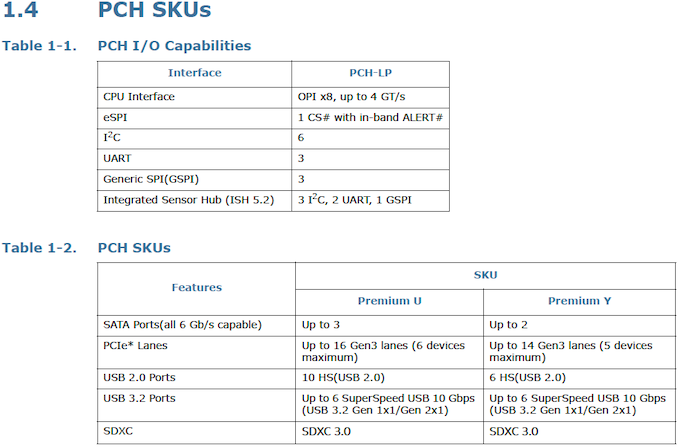Intel’s Comet Lake U&Y 495 Chipset Datasheet: x8 Link, USB 3.2 Gen 2 Support
by Anton Shilov on September 23, 2019 12:30 PM EST- Posted in
- Chipsets
- Intel
- Motherboards
- Ice Lake
- Comet Lake

Intel has published datasheet of its upcoming Intel 495-series chipsets revealing their key features. As it turns out, the family will feature two chipsets aimed at different types of premium laptops, one for Y series and one for U series.
Intel’s 495 chipsets will be compatible with ‘Premium-U’ and ‘Premium-Y’ processors featuring an OPI x8 interface with up to 4 GT/s data transfer rate. Intel’s 495-series PCH will also support up to 16 PCIe 3.0 lanes, up to three Serial ATA ports, up to six USB 3.2 Gen 2 ports (10 Gbps), up to 10 USB 2.0 connectors, an integrated GbE MAC, a built-in Wi-Fi MAC that requires a CNVi module, and all the other familiar features of Intel’s modern chipsets (e.g., RST, AMR, TXT, VT, etc.).
Intel does not disclose in its document codenames of CPUs to be supported by its 495 chipsets, but it is likely that the new PCH will support the company’s latest 10th Generation Core processors known as Ice Lake and Comet Lake. Meanwhile, it remains to be seen which Intel’s chipsets support the manufacturer’s upcoming desktop CPUs.
Related Reading:
- Intel Documents Show Driver Support for Unannounced 400-Series Chipsets
- Intel Adds B365 Chipset to Lineup: The Return of 22nm
- Cypress and Zhaoxin Have USB 3.1 Gen 2 USB Controllers
Source: Intel











44 Comments
View All Comments
psychobriggsy - Monday, September 23, 2019 - link
USB 3.2 Gen 2x1 is simply USB 3.1 Gen 2 rebranded right? The 10Gbps bandwidth version that is old hat by now.If this was USB 3.2 Gen 2x2 then there'd be something worth talking about.
regsEx - Monday, September 23, 2019 - link
Right. CFL already support it.Byte - Monday, September 23, 2019 - link
GD it i almost got excited this had USB 3.2 2x2edzieba - Tuesday, September 24, 2019 - link
Bandwidth is the same, but the newer 'gens' update other parts of the USB spec like power delivery and handling of Alt Mode protocols.azfacea - Monday, September 23, 2019 - link
gigabit Ethernet in chipset coming in 2020 nice. i guess the shit show is now doubling every 18 months at intel instead of transistors.for fucks sake NA is 30% FTTH in 2019. I have 1.5 gigabit fiber internet from bell in toronto for more than a year now. i think residential 10gig fiber will become a thing in this chipsets supposed lifetime and intel is playing hide the PHY with their chipset. nbase-t ethernet was a tiny piece of cmos back when aquentia introduced it 5 years ago (probably at 45nm or 28nm)
Dug - Monday, September 23, 2019 - link
This is a laptop. 99% will be on wireless. These will come with wifi 6. If you need 10Gb ethernet, you can add it to tb or usb. But then 99% of house holds and businesses don't have 10Gb to each user.azfacea - Monday, September 23, 2019 - link
then why have gigabit ethernet ? you either have ethernet or you don't. my problem isnt with the mobile part. my problem is intel shipping garbage from the 90s in 2020 that results in insane situation where wired network is now slower than wirelessclose - Monday, September 23, 2019 - link
@azfacea: "wired network is now slower than wireless"Weelll... In theory at least. Keep in mind that WiFi6 for a single device is more or less as fast as WiFi5 (story changes the more devices we have). Strictly talking about speed every real-life-like test out there will show you that WiFi doesn't really go above 1Gbps even in peaks, let alone average. And having ideal conditions for WiFi is far harder than for wired.
https://www.smallnetbuilder.com/tools/charts/route...
CaedenV - Monday, September 23, 2019 - link
um... that isn't how networking works?When you have an access point, you are still using gigabit ethernet back-haul (with extremely rare exception of some that will do 2.5gbps wired, or 2x1gbps connections).
WiFi throughput numbers include all of the overhead... so in an environment where you have more than 2-3 devices then go ahead and take your rated wifi throughput and divide that by 2. Then divide the remaining badwidth per active users/devices.
After all that, then you cram it down a 1gbps pipe back to the switching network, and an internet connection that is going to typically be well under 100mbps. 1gbps wired is still far superior to any wireless simply because it is a dedicated line with minimal ping times. If you are doing anything with assets that are not local to the machine, then wired is still preferred.
Then there is 10gig Ethernet... which should be a thing, but isn't. And that is not an Intel issue, that is an industry issue. Cisco et all want to keep the 10+gbps at an extreme premium for back-haul technologies. Device manufacturers are afraid to put 10gbps Ethernet on devices because it is hot and power hungry, and does not work well on standardly installed cabling... and the demand for it just doesn't exist. As much as I would love to have 10gig between my desktop and server, it is still just not an option without extra cards, adapters, and better wires. But the industry has decided it is far easier to PCoIP into a VM that has a virtual 10+gig connection to the storage array than it is to do it in the real world with devices spread all over the place.
saratoga4 - Thursday, September 26, 2019 - link
There were some leaked Intel ethernet PHYs with 2.5gbit ethernet support. Probably see that whenever Intel gets off of refreshing 14nm chipsets.